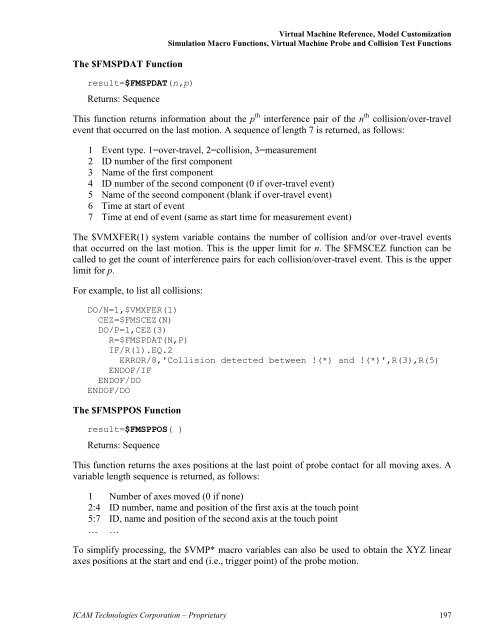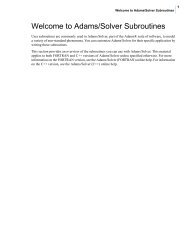Create successful ePaper yourself
Turn your PDF publications into a flip-book with our unique Google optimized e-Paper software.
The $FMSPDAT Function<br />
result=$FMSPDAT(n,p)<br />
Returns: Sequence<br />
<strong>Virtual</strong> <strong>Machine</strong> Reference, Model Customization<br />
Simulation Macro Functions, <strong>Virtual</strong> <strong>Machine</strong> Probe and Collision Test Functions<br />
This function returns information about the p th interference pair of the n th collision/over-travel<br />
event that occurred on the last motion. A sequence of length 7 is returned, as follows:<br />
1 Event type. 1=over-travel, 2=collision, 3=measurement<br />
2 ID number of the first component<br />
3 Name of the first component<br />
4 ID number of the second component (0 if over-travel event)<br />
5 Name of the second component (blank if over-travel event)<br />
6 Time at start of event<br />
7 Time at end of event (same as start time for measurement event)<br />
The $VMXFER(1) system variable contains the number of collision and/or over-travel events<br />
that occurred on the last motion. This is the upper limit for n. The $FMSCEZ function can be<br />
called to get the count of interference pairs for each collision/over-travel event. This is the upper<br />
limit for p.<br />
For example, to list all collisions:<br />
DO/N=1,$VMXFER(1)<br />
CEZ=$FMSCEZ(N)<br />
DO/P=1,CEZ(3)<br />
R=$FMSPDAT(N,P)<br />
IF/R(1).EQ.2<br />
ERROR/8,'Collision detected between !(*) and !(*)',R(3),R(5)<br />
ENDOF/IF<br />
ENDOF/DO<br />
ENDOF/DO<br />
The $FMSPPOS Function<br />
result=$FMSPPOS( )<br />
Returns: Sequence<br />
This function returns the axes positions at the last point of probe contact for all moving axes. A<br />
variable length sequence is returned, as follows:<br />
1 Number of axes moved (0 if none)<br />
2:4 ID number, name and position of the first axis at the touch point<br />
5:7 ID, name and position of the second axis at the touch point<br />
… …<br />
To simplify processing, the $VMP* macro variables can also be used to obtain the XYZ linear<br />
axes positions at the start and end (i.e., trigger point) of the probe motion.<br />
<strong>ICAM</strong> Technologies Corporation – Proprietary 197















